Football forever
All our readers will tell you: Tintin never played football in his adventures. Yet it would seem that he and his accomplices have always been football enthusiasts. But enthusiasts who didn't know it. There are, in fact, signs - and gestures, above all - that do not deceive.
Tintin.com has selected a few of them to show you that, throughout the saga, and even several times per adventure, they freely - and regularly - indulged in their "favourite" sport.
Of course, the original reading of the vignettes we propose here requires you to disregard the context from which they are extracted, to retain only the essential: the nod to football that lurks inside.
Ready to kick off?
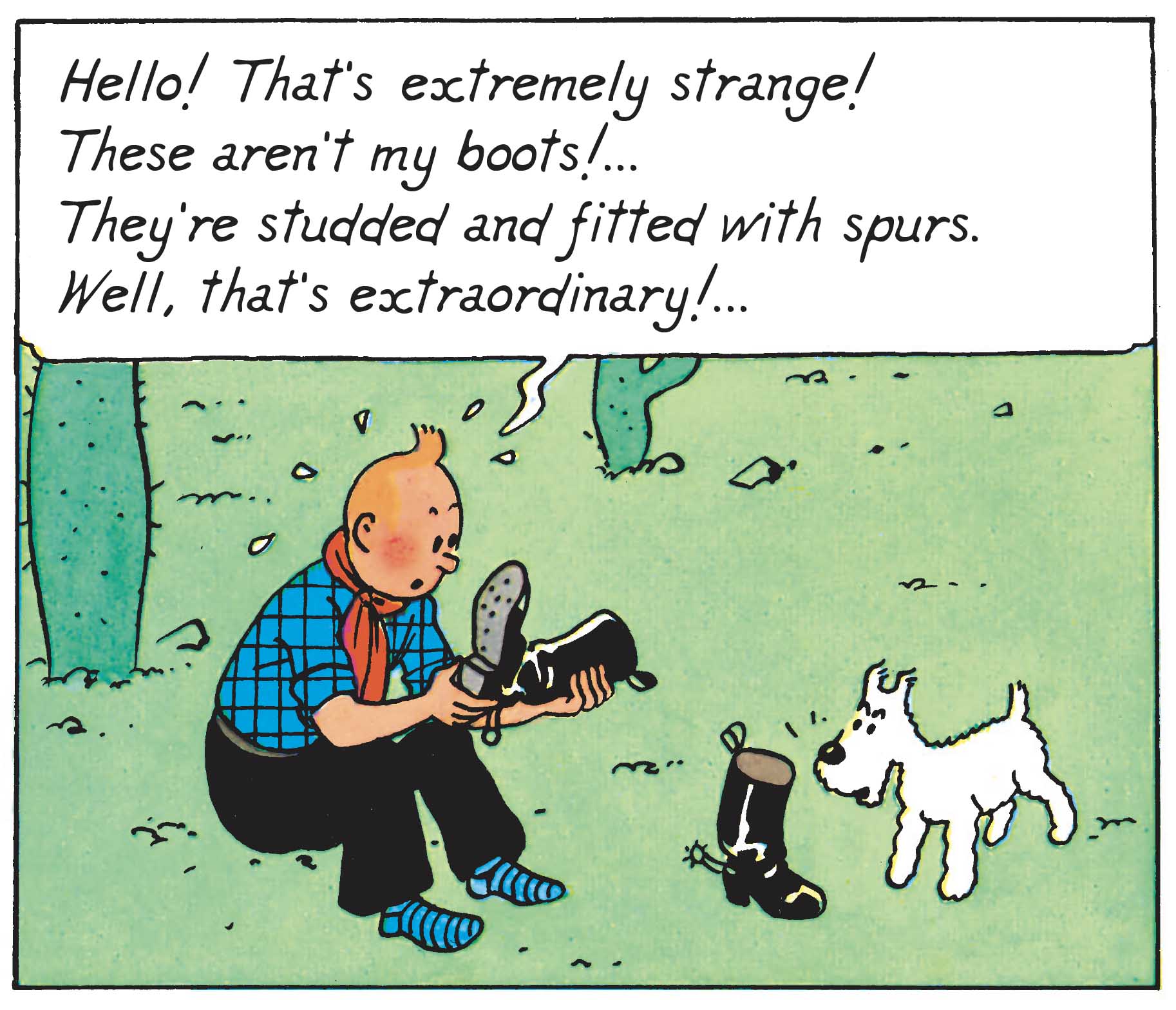
Goalkeeper saves or the art of keeping the line
In the first half... or rather, to begin with, let's put on the goalkeeper's gloves and discover his main missions.
Catching the ball
This is THE fundamental gesture par excellence. For the goalkeeper, it's a matter of seizing the ball and controlling it, in a single movement, with the hands, to stop any opposing offensive action dead in its tracks.
This is precisely what Tintin does in The Black Island.
Following a defensive intervention by Snowy, the young hero has the opportunity to turn the situation to his advantage. All he has to do is grab the revolver lost by one of his two assailants.
With his eyes riveted on the weapon, Tintin positions himself exactly in line with it to catch it at head level. The posture he then adopts is a testament to his innate talents.
So, like a seasoned doorman, he naturally flexes his arms and raises them synchronously to slow the object in its path. He then spreads his fingers so that his hands form a W, so that his ball touch... er, weapon touch, is firm and precise.
His footwork is just as remarkable, with solid support that is both stable and dynamic. He'll be back in action soon enough to get out of this predicament for good.
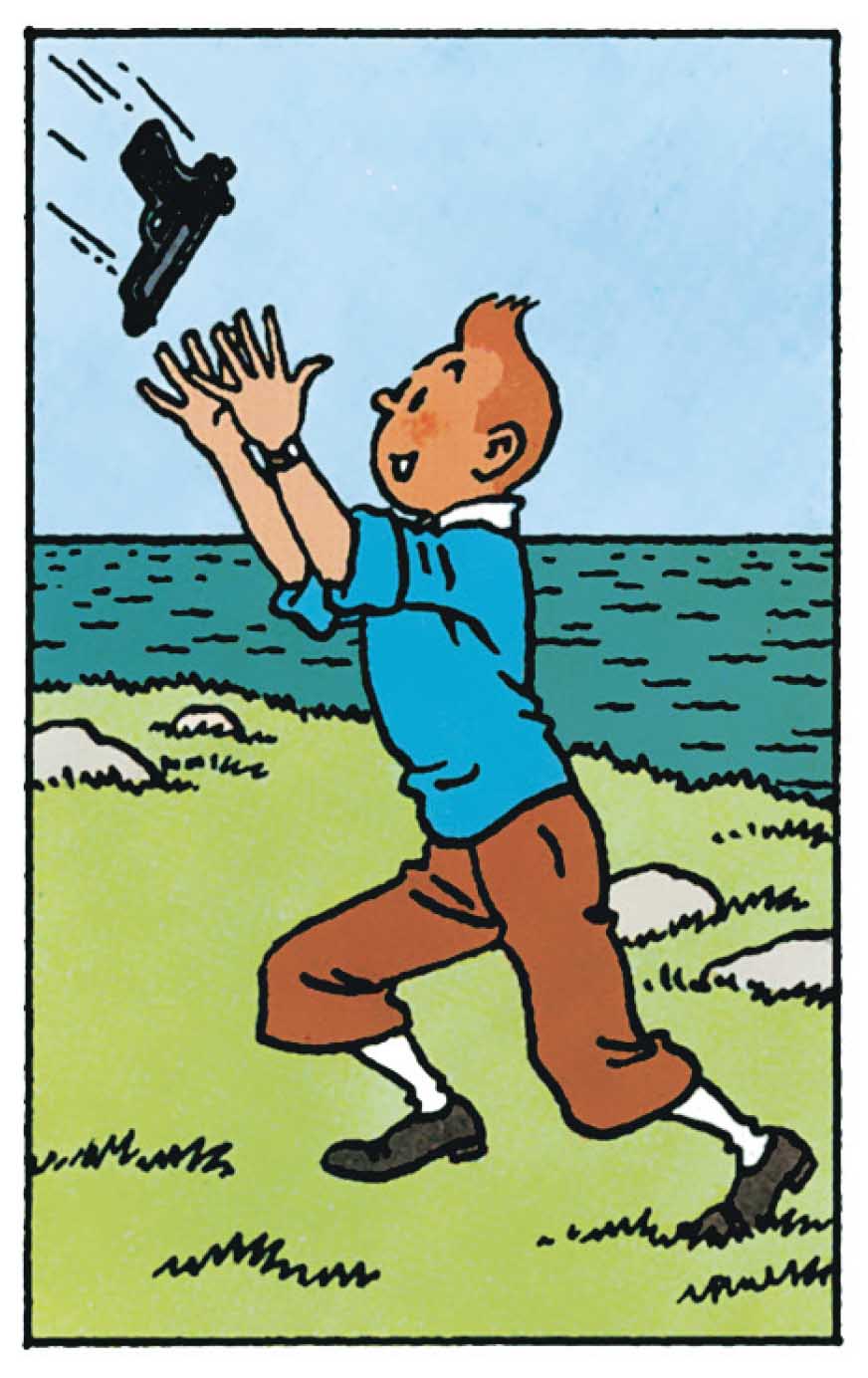
Diving
This spectacular move is made by the goalkeeper when the ball is slightly behind him, or when he's off-course. The goalkeeper then leaps towards the ball, arms outstretched, in an attempt - at all costs - to cut off its path.
In The Broken Ear, Tintin makes a similar stop during a... chess game, to perform an acrobatic "smothered mate" of his own - not with a black knight ambushed in a corner of the chessboard, but rather with his own body, to intercept the bomb that has just been thrown into General Alcazar's office.
The young reporter is certainly gifted. For, despite his slim-fitting uniform and the sword hanging from his belt, he has managed to lower his centre of gravity and, above all, to position his chest forward so as to free his arms completely.
Thanks to this judicious posture, he can pounce on the explosive and prevent it from further igniting an already explosive political situation.
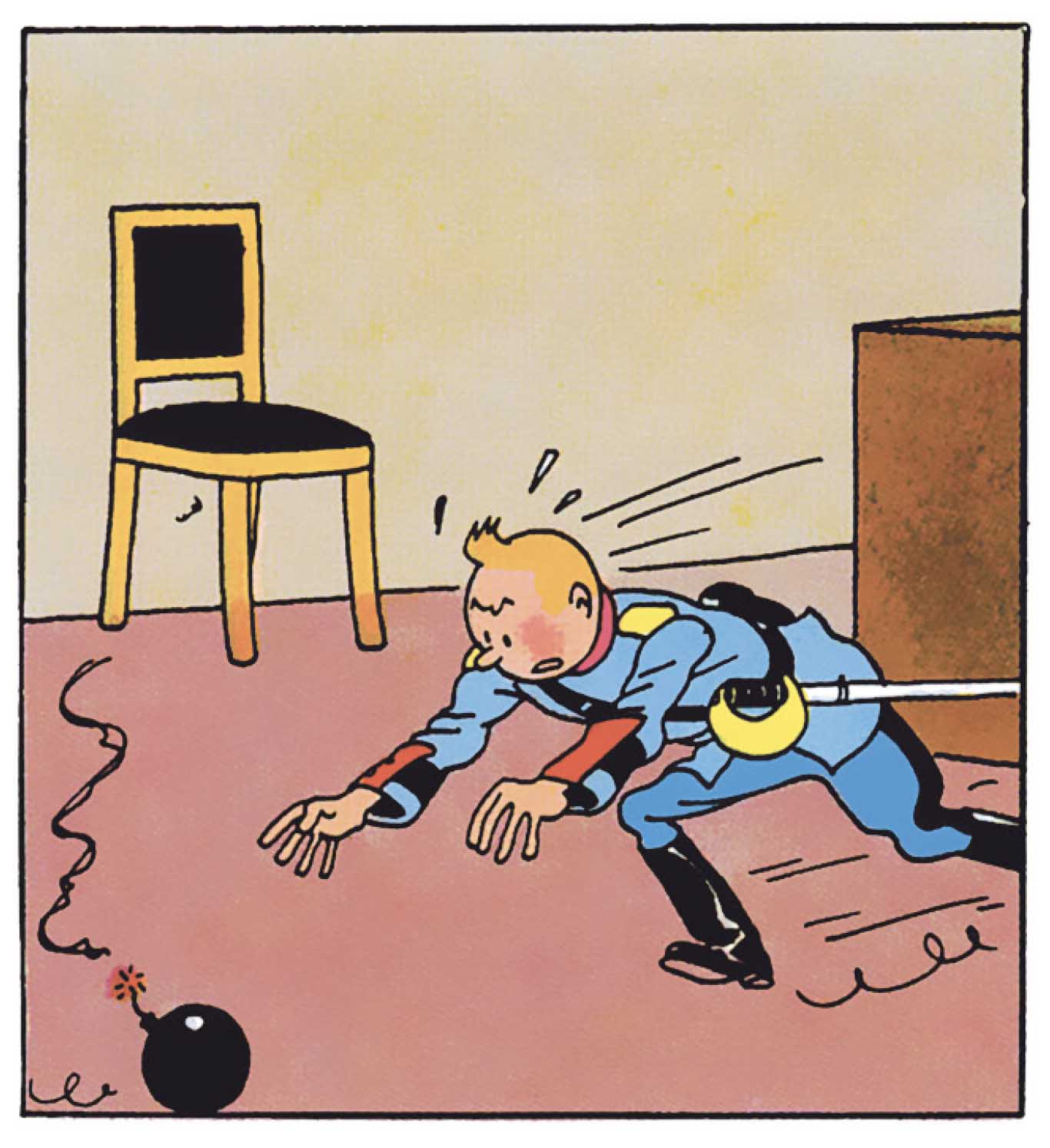
The leap
When the ball goes straight for the net and lodges itself under the crossbar, the lobbed goalkeeper has only one thing to do: jump as high as possible to make a final deflection with his hand.
In The Broken Ear, in pursuit of a witness crucial to his new investigation, Tintin does everything in his power to hold him back, while the witness longs just wants to take flight and regain his freedom.
So he doesn't hesitate for a moment to leap into the air and pull the devil by the tail. And his somersault is prodigious. A sign that he's in top Olympic form.
His explosiveness is indeed very impressive, as he is able to leap quickly and well, with great agility and power, from a standing start. His relaxation is equally impressive, especially for someone dressed in a business suit. Stretching in the morning pays off!
However, his efforts weren't fully rewarded, as the parrot narrowly eluded him without leaving a single feather behind.
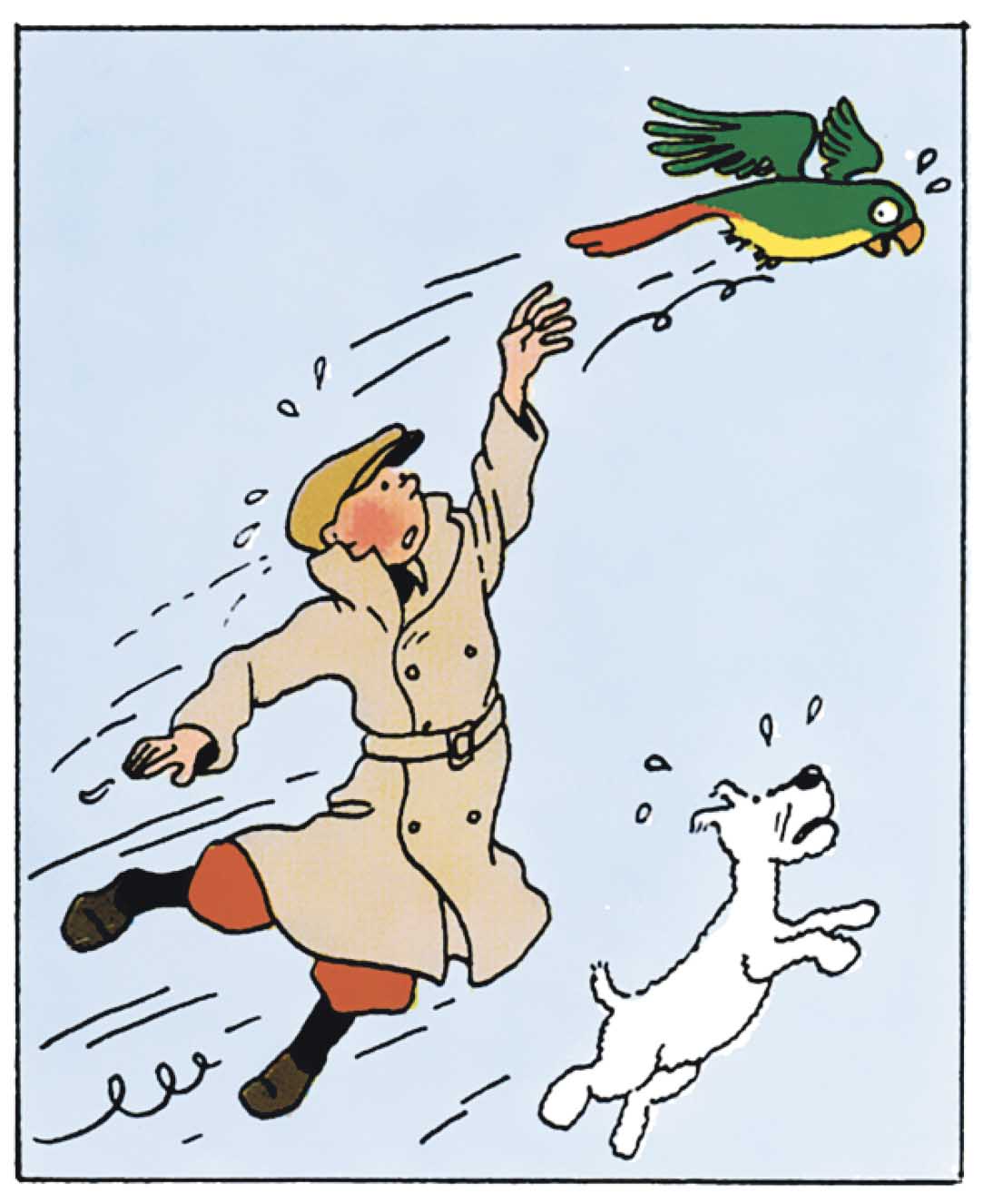
Recovery
A stoppage means a restart. It's only logical. As soon as the goalkeeper gets hold of the ball, he immediately looks for the most appropriate space to pass it to his teammates. He will also act with finesse and strategy, to eliminate as many opposing players as possible. In particular, those who are too far from their own penalty area to be able to retreat into defence.
In The Broken Ear, after his superb low dive, Tintin immediately follows up with an outstretched-arm clearance.
His gesture - too quick - is not lacking in effectiveness, but rather in length. It must also be said that his aim is not to launch a well-intentioned counter-attack, but to foil an attack.
Luckily for him, there's a fountain right under the general's window. Just what he needed to turn the bomb into a damp squib. Phew, that was close!
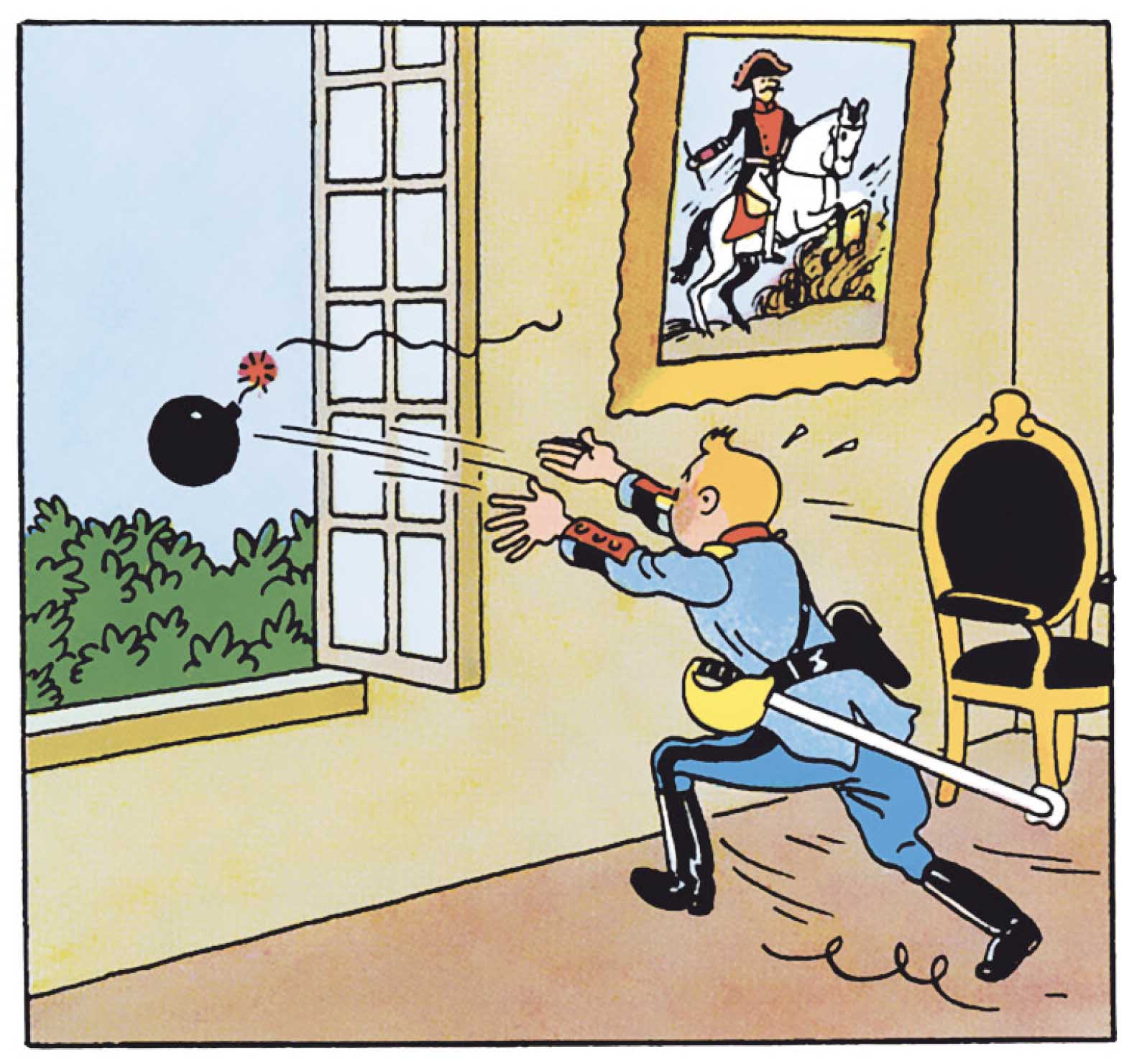
Tricks of the trade for outfield players, or the art of going straight for goal
The first forty-five minutes of play have just elapsed. The start of the second half. An opportune moment to go on the attack and take a closer look at the technical play of the forwards.
The pass
According to Alain Lemoine, author of an article on this subject published in Les objets de la technique. De la compétitivité motrice à la tactique individuelle, this "technical gesture (is) the most widely used in soccer, and learning it is fundamental... (because it is) a communication tool... that enables you to keep the ball, progress towards the target and put a teammate in a shooting position".
In Prisoners of the Sun, Captain Haddock - imprisoned but not giving up - rolls an old newspaper from his pocket into a ball before automatically tapping it, just to keep himself busy. Unwittingly, he makes a superb "ball" transference, with a high, powerful and spontaneous pass.
This strike is executed with the toe of the foot. A practice often decried in the world of soccer as being less elegant than brushing with the flat inside (or outside) of the foot, but which can nevertheless be formidable. Especially if perfectly mastered. Which is the case here.
With his body upright and balanced on his supporting leg, Captain Haddock unleashes a kick of which only he has the secret. His gesture is firm. Precise. No doubt because he has locked his ankle to lift and accompany the "ball" with his foot.
We knew he had sea legs, but we didn't know he was a skilled marksman. Be that as it may, his pass would soon prove decisive...
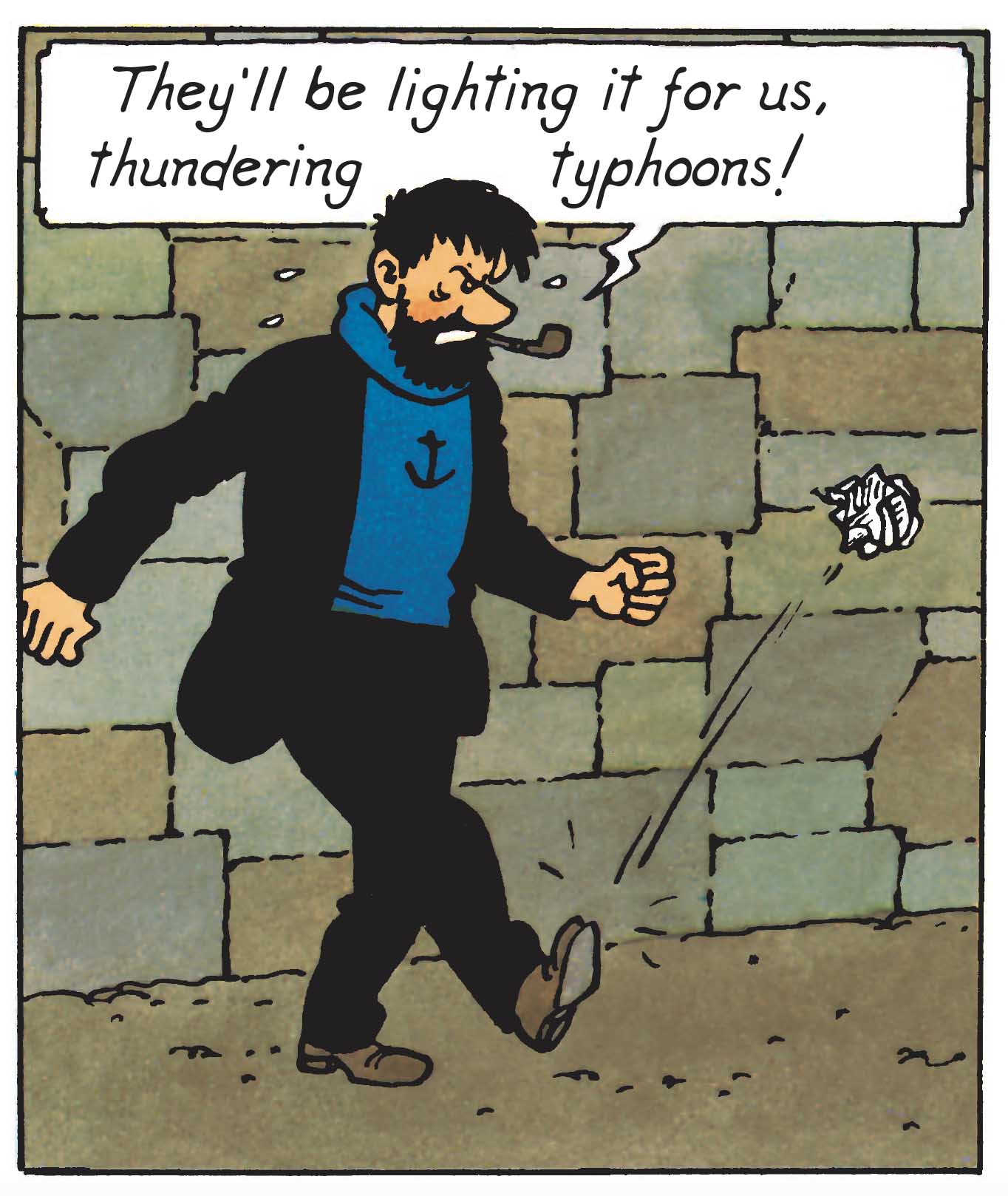
Head control
A pass is only effective if it is followed by control of the ball.
The recipient must intercept, slow down, immobilise and direct the ball, then pass it on to another teammate or score. There are a number of possible techniques for achieving control, including: heading.
In Prisoners of the Sun, the captain's impromptu game of dodgeball in the previous vignette continues with just such an action. Unfortunately, Snowy's aerial game is limited, as he's caught off guard.
It's impossible for him to anticipate and therefore position himself to receive this bell-shaped ball from behind, on the most appropriate area of his skull. As a result, he's more likely to perform an involuntary head check than a shot or a pass extension/deflection.
His intervention is certainly risky, but he has flair all the same, as he manages to cushion Haddock's pellet and place it immediately at his master's feet. A move that made all the difference.
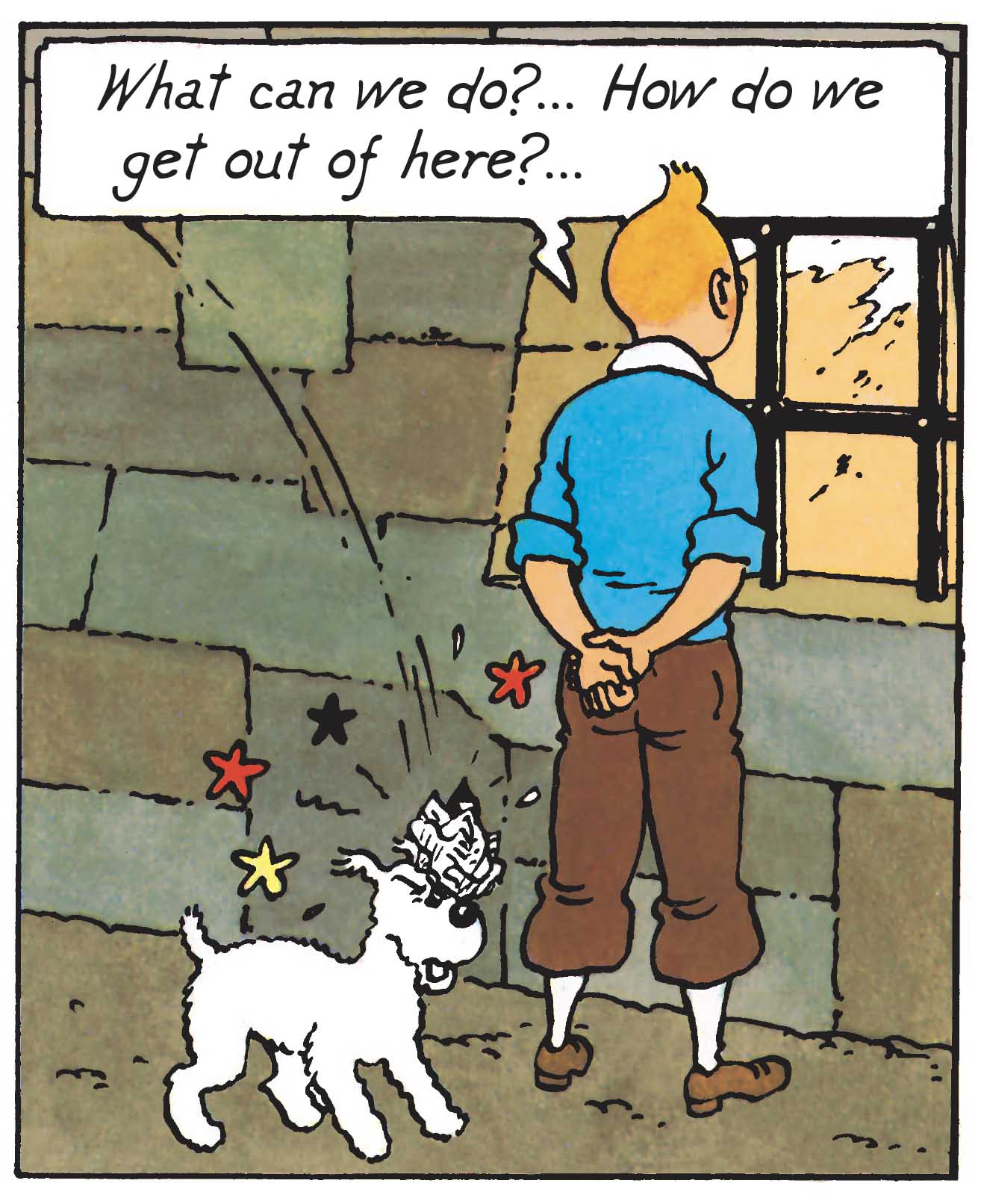
The pigeon wing
Among the acrobatic techniques practised by outfield players, the pigeon wing is one of the most original. Probably because it imitates the flapping of a bird's wing. In effect, it consists of bending the leg backwards to recover and control a ball thrown at half-height. This allows the player to put the ball back in front of him, without changing his support, in order to continue his action.
In Tintin in the Land of the Soviets, the young reporter uses it, stationary on the side of the road, to get rid of a handful of mechanical parts he hasn't been able to reassemble on his wrecked car. An elegant way to get rid of the unnecessary.
However, the gesture is far less spectacular than those performed by real footballers, since he uses a tyre to perform it.
Nevertheless, the rest of the movement is perfectly executed. This allows him to kick judiciously into touch with the back of his foot.
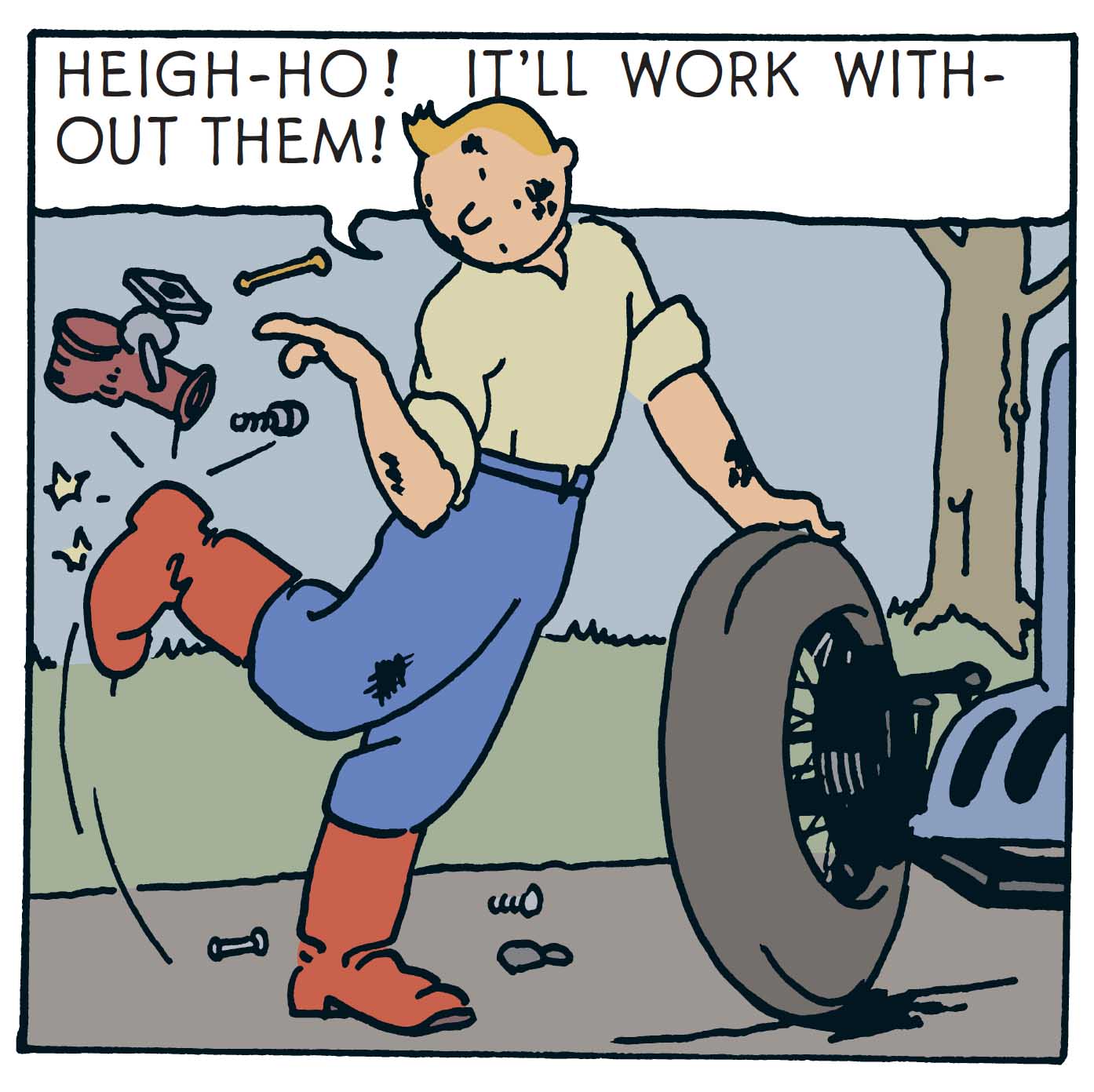
Shot on target
Deflection, lobbed, curled, brushed, all techniques are good, as long as the ball goes into the net.
For a quality shot, the striker is spoilt for choice. He can shoot with the inside of the foot, to be as precise as possible; with the outside of the foot, to give the ball some effect; with the kick, to execute a strong, straight shot; or with the heel for a deflection.
In The Land of the Soviets, Tintin instead uses the tip of his foot to knock out a soldier who marks him a little too close. Firmly planted on his feet, he also lifts off to create a powerful pendulum effect with his shooting leg. As a result, his shoe rises like an arrow, effortlessly, towards the target.
In short, an action that could be summed up as follows: at the end of the shot, he hits... er, he hits the bull's-eye!
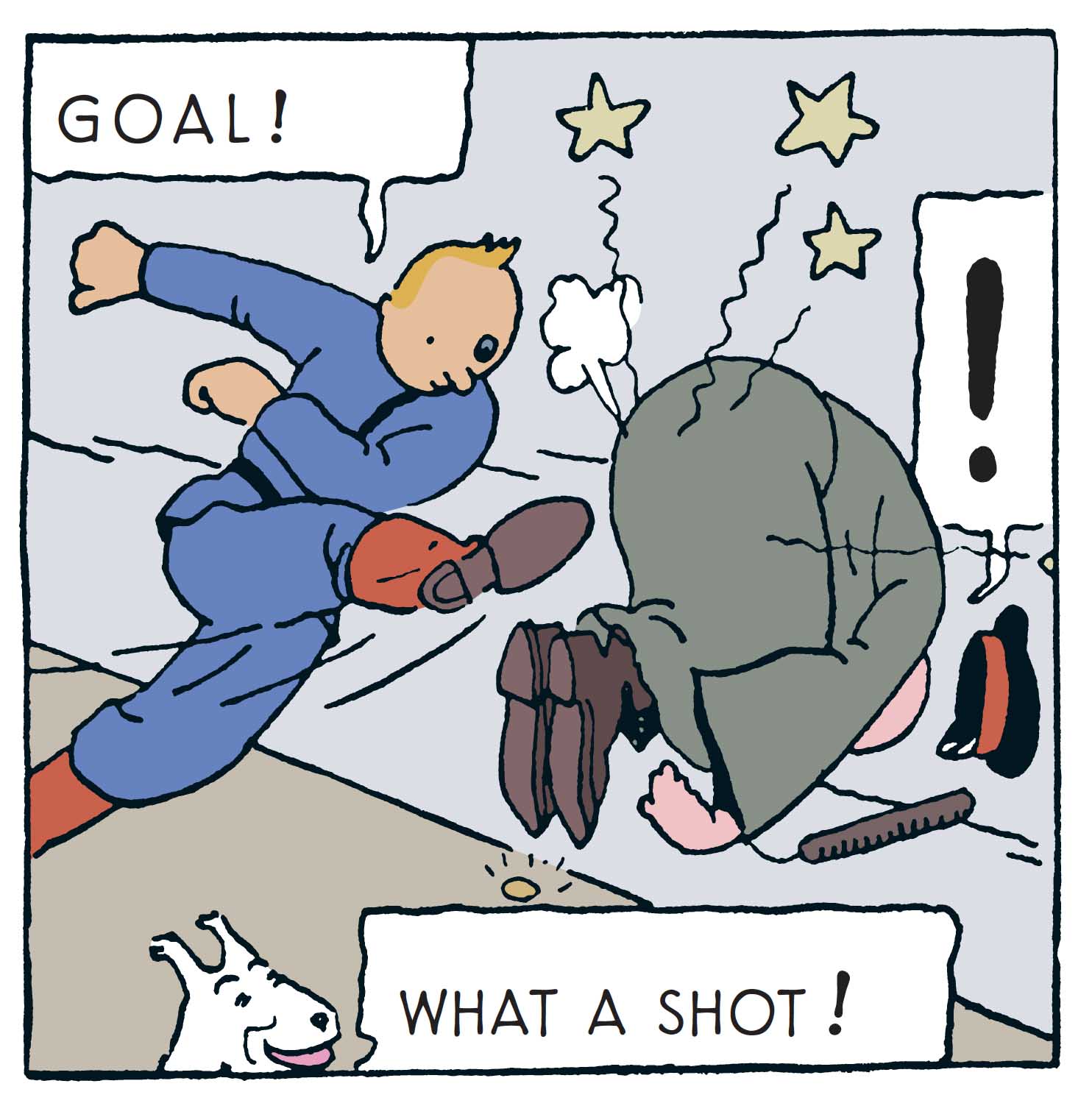
This memorable "goal" marked the end of normal time and the start of extra time. An opportunity to take a quick look back at some of the iconic "fouls" and "stoppages" seen in The Adventures of Tintin.
Well, this time it's the final whistle. The referee has put an end to this surprising encounter. It's time for the players to leave the pitch and return to the changing rooms, and for the tintin.com team to wish the Red Devils, and all our readers, a great Euro 2024!
Texts and pictures © Hergé / Tintinimaginatio - 2024




 News
News Forums
Forums E-books
E-books AMERIQUE P46 B1.jpg)
 CIGARES P40 D3.jpg)
 SOVIETS P56 C5.jpg)
 LICORNE P2 A2.jpg)
 OREILLE P42 B1.jpg)
 TIBET P56 C5a.jpg)



